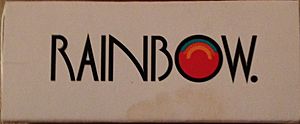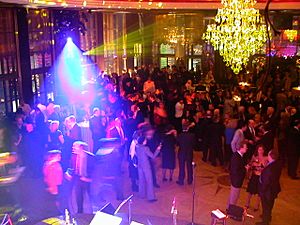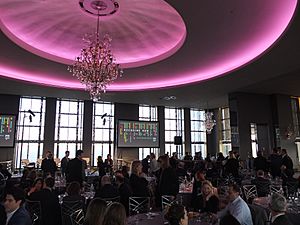Rainbow Room facts for kids
Quick facts for kids Rainbow Room |
|
|---|---|
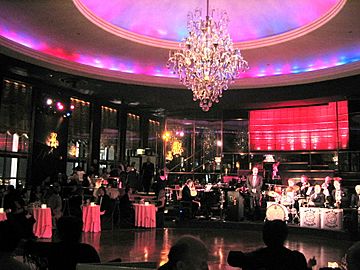 |
|
| Lua error in Module:Location_map at line 420: attempt to index field 'wikibase' (a nil value). | |
| Restaurant information | |
| Established | October 3, 1934 (original restaurant) |
| Current owner(s) | Tishman Speyer |
| Head chef | Mathew Woolf |
| Food type | Classic and contemporary American |
| Dress code | Jackets required (for men only) |
| Street address | 30 Rockefeller Plaza |
| City | New York City |
| State | New York |
| Postal/ZIP code | 10112 |
| Country | United States |
| Coordinates | 40°45′32″N 73°58′44″W / 40.759°N 73.979°W |
| Seating capacity | 300 |
| Reservations | Required except on Sunday mornings and Monday nights |
The Rainbow Room is a special event space located high up on the 65th floor of 30 Rockefeller Plaza in Rockefeller Center in Midtown Manhattan, New York City. It is managed by Tishman Speyer and is one of the highest places to hold events in New York City. The Rainbow Room serves tasty American food, both classic and modern.
It first opened in 1934 and quickly became a popular spot for important people in the city. It was also one of the highest restaurants in the United States. The Rainbow Room had to close from 1942 to 1950 because of World War II. It was updated in 1965 and again from 1985 to 1987 to bring back its original look from the 1930s. After a tough time during the financial crisis around 2008, the Rainbow Room closed in 2009. But it reopened in 2014 after another big renovation.
In 2012, the Rainbow Room was named a landmark by the New York City Landmarks Preservation Commission. This means it's a very important historical place. In 2017, it won an award from the American Institute of Architects for its amazing inside design. Since it reopened in 2014, the food at the Rainbow Room has received good reviews, but it is known for being very expensive.
History of the Rainbow Room
How it Started
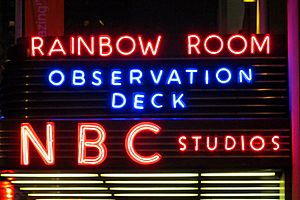
In the 1920s, John D. Rockefeller Jr. wanted to build a new home for the Metropolitan Opera. But those plans changed, and instead, a huge media complex called Rockefeller Center was built. The main building, the RCA Building (now 30 Rockefeller Plaza), opened in May 1933. Soon after, there were ideas to use the top floors, above the 64th floor, as a fun public area. This part of the building had several outdoor spaces, perfect for a dance floor, an observatory, a restaurant, and beautiful gardens.
Many tall buildings in New York City in the 1930s had restaurants or special clubs on their top floors. This became popular after elevators were invented. The idea for a restaurant on top of the RCA Building might have come from the Cloud Club in the Chrysler Building. On the 65th floor of the RCA Building, builders created a tall, two-story space for a dining room. The plan was to have two restaurants on this floor. The Rainbow Grill would be a smaller, more casual place on the west side. The larger restaurant, for dancing and entertainment, would be the future Rainbow Room on the east side. There were also private dining rooms on the floor below.
To get people to these top floors, Westinghouse installed eight super-fast elevators. These elevators were so quick that one was called "the fastest passenger elevator ride on record." Rockefeller Center also opened an observation deck above the Rainbow Room in July 1933. Visitors to the observation deck had to pass through the 65th floor, where the Rainbow Room would be. People even joked that if you were good, you'd go "way up to the Rainbow Room" when you died.
Choosing the Name
The person in charge of the new restaurant wanted a special name. He didn't want it to sound like a regular diner. He wanted a name that showed how high up the RCA Building was and how special the restaurant would be. At first, they thought of calling it the "Stratosphere Room," which sounded like the stratosphere, a layer of Earth's atmosphere.
But in August 1934, the name changed to the "Rainbow Room." This name came from a type of organ that could change colors with the music. The Rainbow Room's special indirect lighting did the same thing, changing colors to match the mood.
Opening Day and Early Years
The Rainbow Room officially opened on October 3, 1934. It started with a big party for 300 guests. Many important and famous people attended the opening celebration.
The Rainbow Room was allowed to serve alcoholic drinks because the United States had recently ended its ban on alcohol in 1933. Even though John D. Rockefeller Jr. himself didn't drink, he agreed to open the Rainbow Room. He was a bit uncomfortable with the idea, but no one else wanted to take the risk. He reportedly didn't enjoy the opening night's entertainment and avoided the Rainbow Room afterward.
The media thought "Jack Rockefeller's saloon and dance hall" would become a huge hit for the rich and famous. And it did! In the years after it opened, the Rainbow Room hosted queens, princes, and princesses from other countries. It became a place where wealthy and important people gathered. Author Daniel Okrent said that the diners were special, separated from "the masses" by high prices and a strict dress code. Formal clothes were required, except on Sundays. Dinners cost $3.50, which was a lot of money back then! The restaurant even had its own special elevators from the lobby.
The Luncheon Club, which was part of the Rainbow Room, was even more exclusive. It had 600 members, and you had to be known by at least two of the club's leaders to even be considered. Women were not allowed in this club. There were also rules about how many Jewish members could join, which some people thought was unfair.
In its early days, the Rainbow Room tried hard to attract the right kind of customers. It was one of the first restaurants with air conditioning and one of the first clubs to open after the alcohol ban ended. Even though it didn't make a profit in 1936, Rockefeller Center used the Rainbow Room's fame to advertise other parts of Rockefeller Center. By the end of the 1930s, the Rainbow Room and Rainbow Grill were called "two of the most successful clubs in the country." In summer 1941, the Rainbow Room made its biggest profits ever.
Later Years
Mid-20th Century
In December 1942, the Rainbow Room closed because of World War II. Many workers were needed for the war effort. The restaurant didn't reopen to the public until 1950, and then only as a cocktail lounge that closed early.
The Rainbow Room closed again in 1965 for updates. These changes brought back the restaurant's original 1930s look. Even though it became less exclusive over the years, it still hosted important people.
On June 16, 1966, the restaurant hosted the 20th Tony Awards, a famous awards show for theater. In 1973, entertainers started performing in the Rainbow Room again for the first time in many years.
In 1985, the Rockefeller family bought all of Rockefeller Center. They decided to modernize many parts of it, including the Rainbow Room. It closed for a huge $20 million renovation. This project made the restaurant much larger. The Rainbow Room reopened in December 1987. Its food, dishes, and decorations were all designed to look like the restaurant did in the 1930s.
21st Century
In 1998, the Italian Cipriani S.A. family, famous for Harry's Bar in Venice, took over the Rainbow Room. They made many changes, including removing some seating areas and adding mirrors. They also closed the restaurant to the general public most of the time. All 250 employees at that time were let go.
In 2011, work began to remodel the restaurant for its reopening. On October 16, 2012, the Rainbow Room was officially named a New York City landmark. This time, the Landmarks Commission decided that parts of the restaurant were old enough to be historically important. It was announced that the Rainbow Room would reopen in fall 2014 after a full restoration.
The Rainbow Room reopened to the public on October 5, 2014, with Tishman Speyer as the new owner. The renovation included the famous dance floor and a new cocktail lounge called Bar SixtyFive. The Rainbow Grill space was taken over by Bar SixtyFive. Now, the Rainbow Room is only open to the public on Sunday mornings and afternoons, and on Monday nights. The rest of the time, it's used for private parties and events. In 2017, the Rainbow Room won another award for its amazing interior design.
Design of the Rainbow Room
The Rainbow Room was first designed by architect Wallace K. Harrison and interior designer Elena Bachman Schmidt. Schmidt helped choose the furniture, curtains, and even the elevator doors. The walls were decorated in a plum purple color, matching the blinds and linens. The original style was seen as modern and elegant. The 1987 renovation gave it a more "American Modern" or simple classical look.
The Rainbow Room is on the eastern side of the 65th floor of 30 Rockefeller Plaza. It's a very large space. The middle of the floor has elevators, restrooms, and private dining rooms. The western part has Bar SixtyFive and an outdoor terrace. The main restaurant area is quite big. You enter the Rainbow Room from the west. Two small staircases lead up to avoid the rotating dance floor. A raised area in the northwest corner gives a great view of the whole room.
The restaurant has very tall, 24-foot-high (7.3 m) windows all around. These windows offer amazing views of the city. Each window has a blind that can be adjusted.
A famous feature of the Rainbow Room is its revolving circular dance floor. This 32-foot-wide (9.8 m) floor can spin in either direction and makes a full turn every 3 to 5 minutes. During the 1987 renovation, the dance floor was covered with a carpet design that looked like a compass star, similar to its original carpet. When it was lunchtime, the dance floor would stop spinning, and they could add 70 more seats on it.
Above the dance floor, there are several round "rings" that go up into the ceiling. The largest ring is 47 feet (14 m) across. A beautiful chandelier hangs from the center of these rings. This is the biggest of the three chandeliers in the Rainbow Room. The room is lit by both indirect lighting and crystal light fixtures on the walls. Mirrors on the walls and around the stage reflect the activity in the room, making it feel even bigger and brighter.
Food and Drinks
The Rainbow Room's menu focuses on Modern American cuisine. In 2017, it was rated as very expensive. This comes from its history as a special club where New York's elite would gather to socialize, enjoy cocktails, eat fine food, and dance on the spinning floor. In 1965, New York Times mentioned dinner choices like coquille joinville and steak. In 1984, New York magazine said the menu was still very similar to the original, except for the prices! Foods like Smoked salmon, oysters, onion soup, and sherbet were on both the original and 1984 menus.
Since it reopened in 2014, the dinner menu has included various appetizers, main courses, and desserts. Appetizers might include salads or a shallot artichoke soup. Main courses have featured scallops, lobster potpie with black truffles, short rib pot roast, beef wellington, roast duck, and baked Alaska.
Brunch at the Rainbow Room is a mix of waiter service and buffet-style servings. There are different buffet bars for "breakfast classics," fruit juices, parfaits, and crepes. They also serve cocktails and desserts during brunch. The Sunday brunches change with the seasons. In 2014, a reviewer from the New York Post praised the "marvelously runny scrambled eggs, honey-baked ham, smoked salmon, sweet-spicy chicken sausage", and French toast.
Bar SixtyFive, the cocktail lounge, has two types of drinks. There's a "classic list" with drinks like a 1915 gin and tonic. There's also a "contemporary list" with items such as ginger beer. Even the cheapest drink on the menu was quite expensive, around $14.


